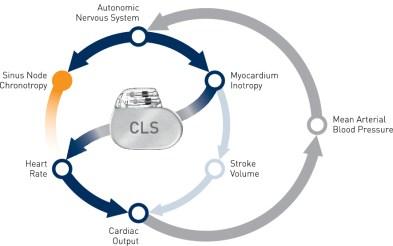How Does CLS Pace Physiologically?
CLS is designed to translate changes in cardiac contractility to increase heart rate - enabling physiologic rate adaptation in patients. Cardiac contractility is the heart's natural mechanism for controlling stroke volume, which along with heart reate, determines cardiac output. By measuring contractility on a beat-to-beat basis, CLS can adjust to each patient's needs, automatically.
Cardiac output is the product of heart rate and stroke volume. Cardiac output is "monitored" by the autonomic nervous system via the mean arterial blood pressure. Changes in the mean arterial blood pressure influence the information coming from the autonomic nervous system, and thus have an effect on the heart rate and contraction dynamics of the myocardium, resulting in the adaptation of the cardiac output to current metabolic demand.
In patients with chronotropic incompetence or other dysfunctions of the sinus node, CLS monitors the contraction dynamics and translates them into proper heart rate adaptation, thus delivering proven physiological therapy. By doing so, CLS emulates a healthy sinus node and it is the only FDA-approved rate-adaptation algorithm to respond to physiologic demands and acute mental stress on a beat-to-beat basis - a feature unique to BIOTRONIK.

What BIOTRONIK devices are equipped with CLS?
CLS is available throughout most of the BIOTRONIK therapeutic cardiac devices:
- Bradycardia therapy: Pacemakers - SR-T and DR-T
- Tachycardia therapy: Implantable Cardiac Defibrillators (ICDs) - DR-T
- Cardiac resynchronization therapy: CRT-D and CRT-P
Frequently Asked Questions
- Are special leads required for CLS to work? No, CLS's proper functioning does not depend on the type or fixation position of the lead. Every unipolar or bipolar lead with passive or active fixation is compatible, as long as the lead is positioned in the right ventricle.
- Can CLS be used in combination with beta blockers? CLS uses a rolling average of the previous 256 resting curves and therefore can quickly and effectively react to changes in the contraction dynamics. Beta-blockers exert an influence on basic contractility and consequently update the reference curve, delivering optimal rate modulation.
- What about changes in basic contractility (e.g. DCM, infections, AMI)? The reference curve adapts to the changed state in basic contractility and calibrates CLS automatically to suit these circumstances.

